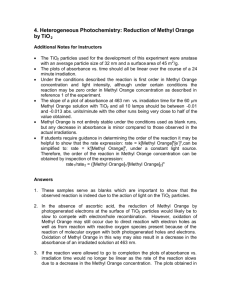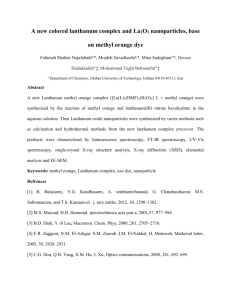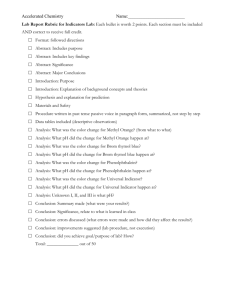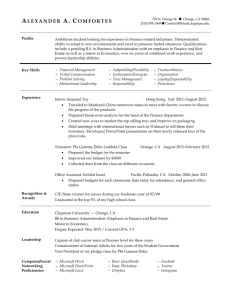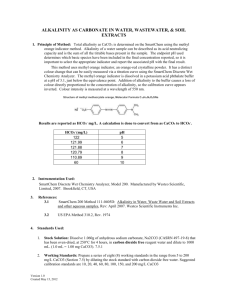4. Heterogeneous Photochemistry: Reduction of Methyl Orange by
advertisement
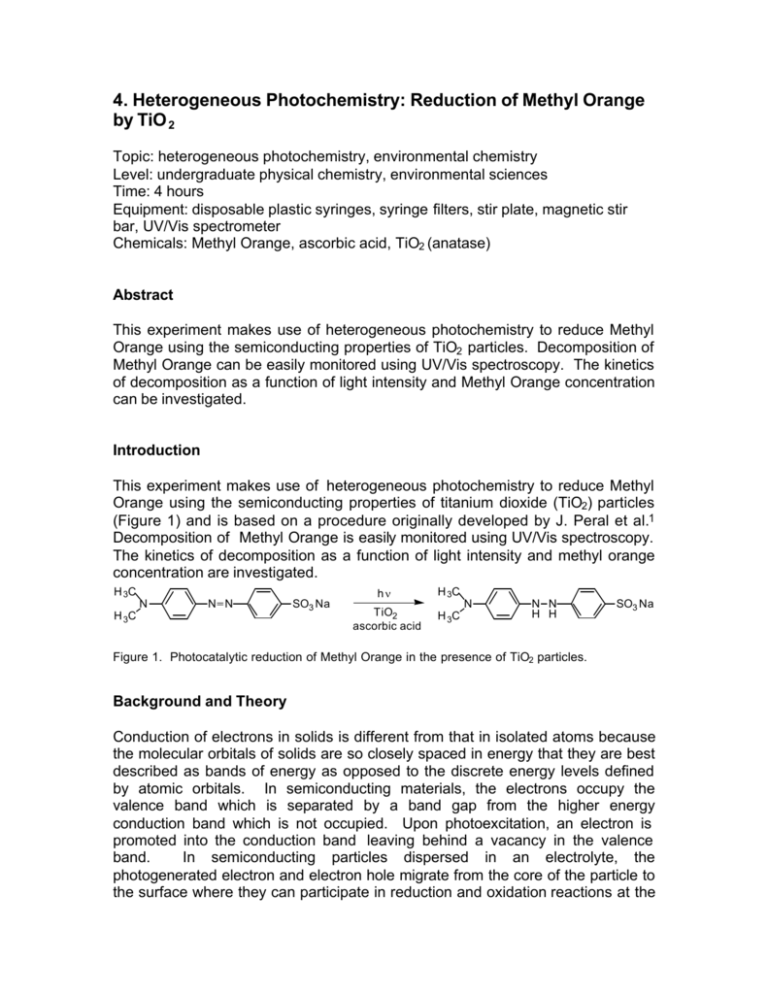
4. Heterogeneous Photochemistry: Reduction of Methyl Orange by TiO 2 Topic: heterogeneous photochemistry, environmental chemistry Level: undergraduate physical chemistry, environmental sciences Time: 4 hours Equipment: disposable plastic syringes, syringe filters, stir plate, magnetic stir bar, UV/Vis spectrometer Chemicals: Methyl Orange, ascorbic acid, TiO2 (anatase) Abstract This experiment makes use of heterogeneous photochemistry to reduce Methyl Orange using the semiconducting properties of TiO2 particles. Decomposition of Methyl Orange can be easily monitored using UV/Vis spectroscopy. The kinetics of decomposition as a function of light intensity and Methyl Orange concentration can be investigated. Introduction This experiment makes use of heterogeneous photochemistry to reduce Methyl Orange using the semiconducting properties of titanium dioxide (TiO2) particles (Figure 1) and is based on a procedure originally developed by J. Peral et al.1 Decomposition of Methyl Orange is easily monitored using UV/Vis spectroscopy. The kinetics of decomposition as a function of light intensity and methyl orange concentration are investigated. H 3C N N N H 3C SO3 Na hν H 3C TiO2 ascorbic acid H 3C N N N H H SO3 Na Figure 1. Photocatalytic reduction of Methyl Orange in the presence of TiO2 particles. Background and Theory Conduction of electrons in solids is different from that in isolated atoms because the molecular orbitals of solids are so closely spaced in energy that they are best described as bands of energy as opposed to the discrete energy levels defined by atomic orbitals. In semiconducting materials, the electrons occupy the valence band which is separated by a band gap from the higher energy conduction band which is not occupied. Upon photoexcitation, an electron is promoted into the conduction band leaving behind a vacancy in the valence band. In semiconducting particles dispersed in an electrolyte, the photogenerated electron and electron hole migrate from the core of the particle to the surface where they can participate in reduction and oxidation reactions at the solid/liquid interface.1-3 A schematic representation of a semiconductor particle undergoing the aforementioned processes appears in Figure 2. A- A conduction band e- band gap hν h+ D valence band D+ Figure 2. A schematic representation of a semiconducting particle undergoing photoexcitation to + give an electron in the conduction band (e ) and an electron hole in the valence band (h ) and their participation in redox reactions. TiO2 is a semiconductor with a band gap energy of 3.23 eV, which can be excited by absorption of light below 390 nm. The redox potential of the resulting species at pH =3 vs. the NHE are:1 TiO 2 + eTiO 2(h +) + e- TiO2(e - ) E = -0.04 V TiO2 E = 3.1 V The use of TiO2 particles in photocatalytic reductions is much less common than their use as oxidizing agents in part because the oxidizing power of the holes greatly exceeds the reducing power of the photogenerated electron.3 Photocatalytic oxidation reactions using semiconductor particles to mineralize potential toxic organic pollutants have been the focus of much research3,4 as well as the topic in many teaching laboratories.2,5-7 Interestingly, it is the reactive oxygen species, such as hydroxyl radicals, which are produced via both the oxidation of water at electron holes and the reduction of molecular oxygen from photogenerated electrons that are proposed to be responsible for mineralization.4 In order to make use of the reductive power of photoexcited TiO2 in this experiment a sacrificial reducing reagent, ascorbic acid, is used to react with the electron holes in order to reduce electron/hole recombination and to compete with the oxidation of water which generates reactive oxygen species which may oxidize the substrate. In this way, the photogenerated electrons are available to reduce the desired substrate, Methyl Orange. Methyl Orange is an aromatic azo compound which are an important class of commercial dyes. The redox potential for its conversion to its hydrazine derivative is 0.067 V (pH = 3 vs. NHE)1 indicating that its reduction by photogenerated electrons in the valence band of TiO2 is thermodynamically favourable. The rate of the Methyl Orange reduction in the presence of TiO2 particles is potentially a function of both Methyl Orange concentration as well as photogenerated electron concentration, i.e., rate = k[Methyl Orange]x [e-]y . While the concentration of Methyl Orange is an easily manipulated experimental variable, the concentration of photogenerated electrons must be assumed to be proportional to the light intensity, which is easily manipulated. Equipment and Chemicals plastic disposable syringes, syringe filters, stir plate, magnetic stir bar, UV/Vis spectrometer, Methyl Orange, ascorbic acid, TiO2 (anatase) Procedure 1. Prepare a solution of ascorbic acid (0.44 g, 0.01 M) and Methyl Orange (4.9 mg, 60 µM) in water (250 mL). 2. Immediately prior to irradiation, add TiO2 (0.05g) to 50 mL of the above solution in an erlenmeyer flask containing a stir bar. 3. Place the solution on a stir plate in a Luzchem photoreactor equipped with 10 lamps ensuring rapid stirring, which is required to keep the TiO2 in suspension. 4. Before beginning the irradiation, remove a 3 mL aliquot of the solution using a plastic syringe which need not be equipped with a needle. Equip the syringe with a syringe filter and dispense the filte red solution into a cuvette. 5. Measure the absorbance of the filtered solution at 463 nm. This value serves as the time zero absorbance value. 6. Irradiate the solution in 6 minute intervals for 24 minutes, performing the absorbance measurements after each interval. 7. Remove 5 of the lamps from the photoreactor (3 from one side and two from the top, closest to the same side) to reduce the light intensity to 50% of the original value and perform the same type of irradiation and absorbance measurements as done previously. 8. Dilute 25 mL of the Methyl Orange/ascorbic acid solution in 25 mL of an ascorbic acid solution (0.044g, 0.01 M) to prepare a solution of Methyl Orange (30 µM) and perform the irradiation with 10 lamps measuring the absorbance in intervals as done previously. 9. Repeat the irradiation and absorbance measurements for 50 mL of the original Methyl Orange/ascorbic acid solution without TiO2. 10. Repeat the absorbance measurements for 50 mL of the original Methyl Orange/ascorbic acid solution without irradiation. Data Analysis 1. Prepare a plot of Methyl Orange absorbance vs. irradiation time containing all of the acquired data. 2. Determine the average rate of the absorbance change from the slope of each of these plots. 3. Based on these plots determine the order of the reaction with respect to Methyl Orange concentration and light intensity/photogenerated electrons. Questions 1. What is the purpose of measuring the absorbance of a solution which has been irradiated in the absence of TiO2 and a solution which has not been irradiated at all? 2. What would you expect to happen if the experiment were performed in the absence of ascorbic acid? 3. Based on your data, what would you expect the plots of absorbance vs. irradiation time to look like if the reaction were allowed to go to completion, i.e, destruction of all of the Methyl Orange? 4. Based on your data, what would the rate of absorbance change be for a sample with 50% of the light intensity and 50% of the Methyl Orange concentration relative to the origina l amounts? References (1) Peral, J.; Trillas, M.; Domenech, X. J. Chem. Educ. 1995, 72, 565-566. (2) Nogueira, R. F. P.; Jardim, W. F. J. Chem. Educ. 1993, 70, 861-862. (3) Fox, M. A.; Dulay, M. T. Chem. Rev. 1993, 93, 341-357. (4) Hoffman, M. R.; Martin, S. T.; Choi, W.; Bahnemann, D. W. Chem. Rev. 1995, 95, 69-96. (5) Bumpus, J. A.; Tricker, J.; And rzejewski, K.; Rhoads, H.; Tatarko, M. J. Chem. Educ. 1999, 76, 1680-1683. (6) Giglio, K. D.; Green, D. B.; Hutchinson, B. J. Chem. Educ. 1995, 72, 352354. (7) Yu, J. C.; Chan, L. Y. L.; Krause, P. J. Chem. Educ. 1998, 75, 750-751.
